Home - All About Braces - How to Know If You Need Braces - Missing Lateral Incisors

Erick practices orthodontics in our Riverton Oral Health office.
Missing Lateral Incisors: Missing Teeth Due to Genetics
Understanding Congenitally Missing Teeth and When Orthodontic Treatment Is Needed.


Missing lateral incisors — the two teeth on either side of the front top teeth — are one of the most common congenital dental conditions. This condition, known as hypodontia, often runs in families and can lead to spacing issues, bite problems, and long-term complications if not treated early.
Because these teeth are typically lost or never develop at all, it’s common to see gaps, peg-shaped teeth, or misalignment in the smile.
Why Are Lateral Incisors Missing?
- Missing lateral incisors may also be accompanied by:
- Smaller or peg-shaped lateral teeth
- Delayed eruption of neighboring teeth
- Over-retained baby teeth
- Midline shift or asymmetry
How to Tell If Your Child Has Missing Lateral Incisors
- A gap on either side of the front top teeth
- Baby teeth that never fall out
- Front teeth drifting out of alignment
- Crowding or tipping of the canine teeth
- A narrow smile or off-center midline
Why Early Orthodontic Guidance Matters
- Space closure: Braces bring the canine teeth forward to fill the space, and the shape is later adjusted with bonding or veneers
- Space opening: Braces or aligners maintain or create space for future implants or bridges
Treatment Options
- Braces (metal or ceramic) to close or open space
- Invisalign® for teens with mild spacing concerns
- Cosmetic reshaping of nearby teeth
- Space maintainers in younger patients
- Dental implants or bridges (once growth is complete)
Your orthodontist will help guide this process with long-term outcomes in mind — often starting as early as age 8 or 9.
When to Schedule a Consultation
If you’ve noticed gaps where adult teeth should be, or your child’s lateral incisors never arrived, schedule a complimentary consultation with our orthodontic team. Early diagnosis allows for the best timing and treatment planning — and helps ensure a confident, healthy smile as your child grows. Learn more about the types of braces that can help support space closure or replacement.
Claim Your Complimentary Consultation
Our orthodontic team is here to help with complimentary orthodontic consultations in Bluffdale, Riverton, Stansbury Park, and West Jordan.
Complete the form below or call (801) 254-9700 to schedule.
Frequently Asked Questions
Is it normal to be born without lateral incisors?
It’s not uncommon. Around 2–4% of people are born with one or both lateral incisors missing due to genetics.
Can braces fix missing teeth?
Yes — braces can either close the space or hold it open for future tooth replacement, depending on your child’s case.
When is the best time to treat missing lateral incisors?
Early — usually around age 8–10 — so your orthodontist can guide the jaw, bite, and tooth positioning before growth finishes.
Do missing lateral incisors affect bite function?
They can. Missing teeth can cause neighboring teeth to drift and impact how the upper and lower teeth fit together.
Will my child need dental implants?
Not always. Some cases are treated with space closure using braces; others wait until the jaw is done growing and place implants or bridges.